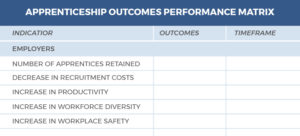In recent years, the manufacturing industry has been facing an enormous obstacle to profitability and productivity: unfilled high-tech jobs. Companies are struggling to attract, train, and retain new talent, and these vacancies result in soaring financial losses.
Staff shortages lead to costly and far-reaching repercussions for manufacturers, including unplanned downtime, worker overtime, and high turnover. And while U.S. manufacturers reported in April 2018 that demand for goods is strong, they said an inadequate workforce is contributing to stagnant growth and lost potential sales. One automotive supplier in the Midwest concluded the skills gap in their maintenance department was costing them over $6 million per year.
Manufacturers need a sustainable workforce development strategy to address this problem, and for many, establishing an apprenticeship program is a smart solution. A well-executed program helps companies address skills gaps, retain talented employees, and improve workplace morale. It combines rigorous academic learning, practical hands-on training, and company-specific mentorship. An apprenticeship program also prioritizes offering mid- to long-term career pathways, an attractive proposition for potential employees.
But an apprenticeship program requires an initial investment of time and money to be successful. Study after study shows that this investment pays dividends, and yet each company’s calculation will be different. A report from the nonprofit Urban Institute, funded by the Department of Labor, Employment and Training Administration, encourages companies to calculate the return on investment (ROI) of an apprenticeship program to get buy-in from senior leaders and managers.
The ICATT Apprenticeship Program team works with employers to help them calculate the cost of the skills gap, using these metrics to set concrete goals for the program before getting it off the ground.
It recommends employers ask questions such as:
- Which areas of the business are currently facing the greatest challenges in hiring? Which areas will be most affected by the coming wave of retirements in the baby boomer generation?
- How much are we spending to attract and retain talent? How effective are these efforts?
- What is the typical cost for onboarding and fully training a new employee in the business areas affected by the skills gap?
- How much is the skills gap causing in overtime costs? What downstream effects of overtime have been experienced (turnover, morale issues, etc.)?
- How much is the skills gap causing in quality issues, delays, and other production issues?
Once the full costs have been evaluated, making the case to senior leadership for an apprenticeship program becomes more transparent. Now companies can start setting expectations for outcomes of an apprenticeship program in each of these areas.
In addition to examining the need for an apprenticeship program, companies should also look carefully at their own capacities before committing to a program. Internal evaluation should include topics such as:
- What support do we need from front-line managers to manage an apprenticeship program?
- Who will train and mentor the apprentice on a daily basis? Do we have sufficient resources to enable a trainer to dedicate time to training? If training is taking away from productivity, how will this affect the trainer’s compensation?
- How do we ensure effective training?

These answers will form the foundation for measuring a program’s readiness and ultimate outcomes. A successful program will carefully select apprentices, set goals, and track ROI; this matrix adapted from the U.S. Department of Labor is a helpful model which companies can adapt for their own use:
With the amount of work and preparation that is required to ensure an apprenticeship program’s success, many companies purposefully choose to work with the ICATT Apprenticeship Program, whose time-tested approach ensures standards of excellence are met.
Get more details on how the ICATT Apprenticeship Program can help companies succeed. The ICATT team can help companies benchmark the cost of their skills gap and determine the ROI of a potential apprenticeship program.
